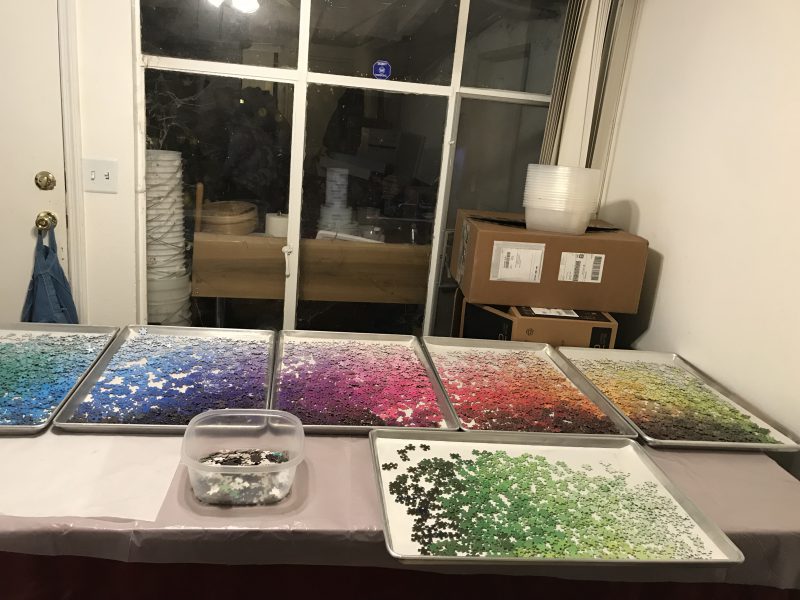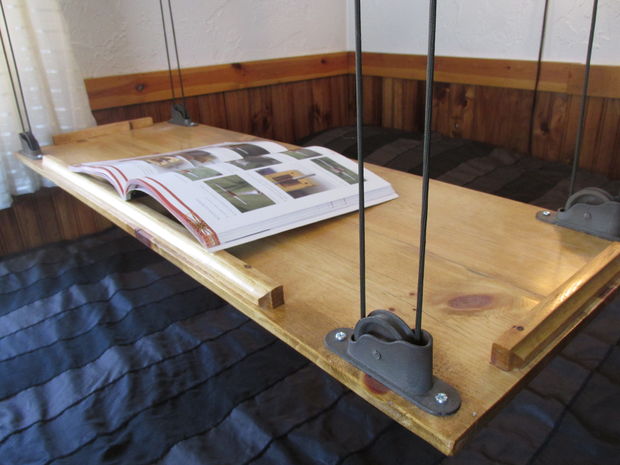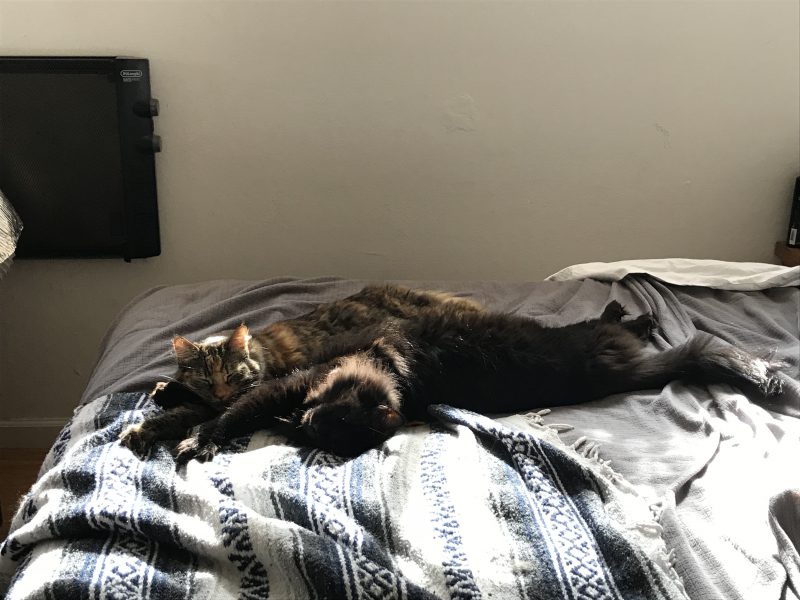13.5 hours of sorting later, all 5000 pieces are neatly arranged by color:

The plastic box contains all the edge pieces, and all the rest of the pieces are sorted more or less by color (hue/value).
Now come the difficult strategic decisions. Those living in the mortal world would naturally start by putting together the edge pieces, then adding pieces, building towards the center. It’s the traditional method, and also the most efficient approach for most puzzles.
However, I do not live in the mortal world, but a world dominated by two puzzle gods, whose mighty powers no mere mortal can withstand. Their razor-sharp claws, lightning paws, and fearsome fangs are devoted to one pursuit and one pursuit only: stealing puzzle pieces from the puny humans and making them disappear. (They’re also pretty darn cute, which is why they get away with it. 😉 )
So before moving on, I needed to design and create the Strategic Puzzle Defense System. This is the sort of project that obviously needs expert technical help, and some of my Caltech friends were happy to oblige. My friend Karen started simply, by recommending a puzzle mat. These are large pieces of fairly stiff, slightly sticky cloth (usually felt), on which one assembles the puzzle. At the end of each session, you roll the puzzle mat around a tube, with the pieces still inside. The slight “tooth” of the felt keeps the puzzle from disintegrating, and the tube keeps everything stable.
There was only one problem: at at 30″ x 80″, the puzzle was almost 20″ too long to fit, even on the largest commercial puzzle mat I could find.
“Yoga mat?” asked Karen.
“Still too small,” I said.
“Two yoga mats and a lot of duct tape?”
“Uh….”
At this point, Scott (Karen’s partner and another Caltech alum) popped in with another modest suggestion: Mount a large piece of plywood to the ceiling, then lift and lower it out of feline reach using paracord and pulleys. He was even helpful enough to point me at directions for creating my own plywood-and-paracord table on Instructables.

While mounting an entire 4’x8′ sheet of plywood to the dining room ceiling and rigging up a pulley system to lift and lower it would have been an awesome (and elegant – er, sorta) way to protect the puzzle, there would have been a few downsides, such as the inevitable destruction of the dining room chandelier. Also, since one of our mighty puzzle gods loves climbing into high places, unless the plywood were pulled right up against the ceiling, she could probably still get in.
(It has since been pointed out to me that a more efficient approach – at least in terms of materials – would be to skip the plywood and simply mount the pulleys, etc. directly to the dining room table, drawing it up to the ceiling when not in use. Because having a 100-pound object hanging from the ceiling in a high-traffic area (right next to the back door) is a Really Good Idea. What could go wrong?!?)
After reluctantly dismissing the Great Puzzle Elevator approach, I went back to the puzzle mat idea. It seemed like it could work, and of course the most obvious way to solve the size problem would be to make my own. So I went online, read up about making your own puzzle mat, and then went off to the craft store in search of the materials.
Now, as anyone who knows a theoretical scientist will tell you, with enough inspiration and dogged persistence, an inventive person can make any task arbitrarily complicated. (Theoretical scientists will tell you that their job is actually to simplify our understanding of things, but – having grown up in a community of them – I’m occasionally a bit, um, skeptical. 😉 ) So there I was, in Jo-Ann Fabrics, with the simple task of going in and buying 3 yards of felt. Given that the store was nearly empty, this should have taken at most five minutes.
It wound up taking nearly forty-five minutes. I grappled with difficult design decisions, missing information, and my natural thirst for advancing human knowledge. Fleece fabric was on sale, and also has a slightly sticky surface. Could it be even better than felt? And what kind of felt would be best – wool-rayon, polyester, or “craft felt”? Would the puzzle pieces stick to the back of the felt if I used unlined felt? If I lined it, would the lining come out better if I just sewed it at the edges, or should I quilt it down? Would fusible web be better for attaching the lining to the felt? There were three kinds of fusible web -which kind would be best?
Being the daughter of two scientists, my natural response to these sorts of situations is usually “Buy/make one of every possible option, test them all, write up the results, and publish it.” This would have been great for every other human craving to know how to make the most devastatingly effective 30″ x 80″ puzzle mat possible. But probably not the wisest use of 100 hours, especially since I have finished exactly one puzzle in the last two decades and have probably only a 50% chance of finishing even one more puzzle in the next two decades. So – after forty-five minutes of hand-wringing and materials analysis, I throttled back my scientific instincts, bought the felt and some fusible web, and went home.
Once I got home, of course, I realized that I’d made the classic engineer’s mistake: Designing a product without thinking about how I was going to use it. The table was almost exactly the size of the puzzle, so rolling and unrolling the puzzle mat would very likely send some puzzle pieces sliding off the edges, particularly if I had started around the edges of the puzzle, as traditional. I could start assembling the puzzle in the middle, but the friction of the felt might make it hard to move the puzzle around if I needed more space on either edge. I thought up some other possible workarounds, but eventually concluded that it would be hard to make the puzzle mat work.
So – having exhausted all the complicated options – I’m returning to the simplest one: put the puzzle together on the table, and cover it with a dropcloth at the end of each session. I’ll start in the middle, where the colors are easy to differentiate, and work my way out to the border pieces, so they’re not dangling off the edges of the table the entire time. Simple, and probably quite effective.
I am ruefully reminded of my favorite quote by Immanuel Kant, which I first saw (very appropriately) scrawled as graffiti in one of the student Houses at Caltech:
Here as elsewhere human reason in its pure use, so long as it was not critically examined, has first tried all possible wrong ways before it succeeded in finding the one true way.
Of course, I’m sure that the cats’ reaction to the puzzle, now that I’ve put so much time and thought into protecting it from them, will probably be this:
Happy holidays from me, Mike, and the cats! Wishing you a joyful and peaceful year to come.


Oh Tien, you’re a hoot! I hope we can meet at Convergence.
Great story and I enjoyed it! Merry Christmas and Happy New Year to you and your family.
The same good wishes right back at ya!
Occam’s razor tells us that the simplest solution/explanation/strategy is probably the best, right?
I my put together a jigsaw puzzle tomorrow myself,,,but not with 5000 pieces!
Happy Holidays Tien!
I love your posts!
Having dealt with 5000 piece puzzles and puzzle gods, and seeing as how you’ve done such a beautiful job of sorting into those very useful trays, I would assemble by color sections in the trays themselves and then use the parchment paper to transfer the sections to the table for final assembly.
You are so funny, I love it! We use a table cloth as drop cloths tind to be crinkly. We tie weights on the corners and collected rocks on top. We don’t even have a cat, but it’s the only table we have and we do like to use it for other things.
We have spent many, many, too many hours on the black and white puzzle and we aren’t even half finished.
You might also have luck with an extra-long twin fitted sheet, especially if you can find one that doesn’t have the 14″ corners. It’s less likely to get pushed around because it’s made to go on a 39″ x 80″ mattress, and would fit more snugly than the drop cloth
And a VERY MERRY CHRISTMAS to you and Mike and the kit-ties!
I love this story. There better be some fabulous metaphorical end when you finish the puzzle, which, I hope, is well before Convergence. And I look forward to seeing you again there.
Janet
Love these dissertations!